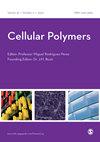集成熔融沉积建模(FDM)3D打印技术的气批发泡微孔发泡复合材料的形态评价
IF 1.3
4区 医学
Q4 MATERIALS SCIENCE, BIOMATERIALS
引用次数: 3
摘要
在本文中,微孔结构泡沫的发展是通过整合两种成功的和现有的技术,即CO2气体间歇发泡和熔融沉积建模(FDM) 3D打印技术。这是一种为定制应用制造复杂设计多孔产品的新方法。挤压3D打印长丝的最终细胞形态取决于与微孔发泡和3D打印工艺相关的工艺参数。此外,形态学研究已经进行,以评估通过定制FDM设置开发的3D打印长丝的细胞形态。在此过程中,对饱和压力、饱和时间、脱附时间、进料速率和挤出温度等工艺参数的意义进行了深入研究。本研究采用丙烯腈-丁二烯-苯乙烯(ABS)为基材。3D打印的细丝由细胞组成,细胞平均尺寸在2.3-276µm之间,细胞平均密度在4.7 × 104 ~ 4.3 × 109 cells/cm3之间。最后,通过控制工艺参数,可以根据最终应用开发出不同的细胞形态。本文章由计算机程序翻译,如有差异,请以英文原文为准。
Morphological evaluation of microcellular foamed composites developed through gas batch foaming integrating Fused Deposition Modeling (FDM) 3D printing technique
In this article, the development of microcellular structure foams has developed by integrating the two successful and existing technologies, namely CO2 gas batch foaming and Fused Deposition Modeling (FDM) 3D printing technique. It is a novel approach to manufacture complex design porous products for customized applications. The eventual cell morphologies of the extruded 3D printing filament depends on the process parameters pertaining to both microcellular foaming and 3D printing processes. Further, morphological study has been conducted to evaluate the cell morphologies of the 3D printing filament developed through customized FDM setup. During this process, the significance of various process parameters including saturation pressure, saturation time, desorption time, feed rate and extrusion temperature were thoroughly studied. To pursue this study base material used was acrylonitrile butadiene styrene (ABS). The 3D printed filaments consisted of cells with an average cell size in the range of 2.3–276 µm and the average cell density in the range of 4.7 × 104 to 4.3 × 109 cells/cm3. Finally, it has found that by controlling the process parameters different cell morphologies can be developed as per the end application.
求助全文
通过发布文献求助,成功后即可免费获取论文全文。
去求助
来源期刊

Cellular Polymers
工程技术-材料科学:生物材料
CiteScore
3.10
自引率
0.00%
发文量
9
审稿时长
3 months
期刊介绍:
Cellular Polymers is concerned primarily with the science of foamed materials, the technology and state of the art for processing and fabricating, the engineering techniques and principles of the machines used to produce them economically, and their applications in varied and wide ranging uses where they are making an increasingly valuable contribution.
Potential problems for the industry are also covered, including fire performance of materials, CFC-replacement technology, recycling and environmental legislation. Reviews of technical and commercial advances in the manufacturing and application technologies are also included.
Cellular Polymers covers these and other related topics and also pays particular attention to the ways in which the science and technology of cellular polymers is being developed throughout the world.
 求助内容:
求助内容: 应助结果提醒方式:
应助结果提醒方式:


